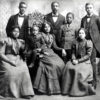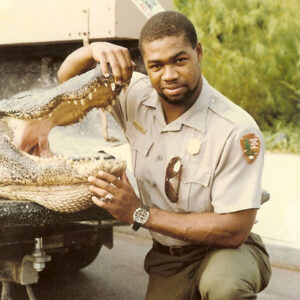calsfoundation@cals.org
Bruce "Sunpie" Barnes (1963–)
Bruce “Sunpie” Barnes is a musician, writer, naturalist, park ranger, ethnographic photographer, and actor from Saline County. He also played for National Football League (NFL) for a time. Along with his band, the Louisiana Sunspots, Barnes pioneered a unique mixture of zydeco (a créole musical style originating in Louisiana), blues, gospel, jazz, and African and Afro-Caribbean music into a musical gumbo that he dubbed “Afro-Louisiana” music. Barnes plays accordion, harmonica, piano, trombone, rub board, and various other instruments.
Bruce Barnes was born on May 18, 1963, in Benton (Saline County). The tenth of eleventh children, (five whole and five half siblings), Barnes grew up in what is now Benton’s Ralph Bunche community. Barnes’s parents were sharecroppers who worked on various plantations in southern Arkansas and the Delta before migrating north to find work in Saline County’s open-pit bauxite mines. In Bauxite (Saline County), Barnes’s family lived in tar-paper shacks in what was known then as “Africa Camp” before moving to Benton.
Barnes’s first exposure to music came through his father, Willie Barnes Sr., who was a blues harmonica player. Willie Barnes Sr. was raised on plantations around fellow musicians such as “Big Bill” Broonzy, Sonny Boy Williamson II, and Roosevelt Sykes. Because his father was reluctant to pay for piano lessons for him, he taught himself instead, taking the name “Sunpie” from an uncle who routinely visited from Bastrop, Louisiana. In junior high at Benton, Barnes worked nights at a nearby ice factory to help his mom buy his first instrument, a trombone. Barnes later learned the harmonica from his father. Soon, Barnes was playing songs by his father’s favorite bluesman, Sonny Boy Williamson.
In high school, Barnes played football for the Benton Panthers and ran track. He was also first-chair trombone in the junior and high school bands. Barnes graduated in 1982 and received a football scholarship to Henderson State University in Arkadelphia (Clark County). While at Henderson, Barnes earned All-American status as a defensive end, in addition to majoring in biology with a focus on ichthyology and serving as president of the Biological Honor Society. Barnes conducted biological fieldwork in local lakes, rivers, and streams as a part of his coursework at Henderson. Barnes’s biological studies led him to the National Park Service (NPS), where he worked for three seasons on the Buffalo River.
Soon after starting his work with the NPS, Barnes caught the attention of professional football recruiters. In 1985, he accepted a contract with the Kansas City Chiefs. He played a single season with the Chiefs and was later offered a chance to play in the Canadian Football League. In 1986, however, Barnes decided that football was not for him.
Barnes started working with the NPS again in 1987, becoming a park ranger and naturalist at the Jean Lafitte National Park and Barataria Nature Preserve, respectively; both are located just outside New Orleans, Louisiana. He conducted educational tours of the 23,000-acre wetland preserve, and he played in local venues in the evenings. The left-handed Barnes played the accordion upside-down and backward while he sang, although he later trained himself to play it right-handed and right-side-up. He appeared in Sprite and McDonald’s commercials with his accordion.
By 1991, Barnes had formed his band, Sunpie and the Louisiana Sunspots, which became a fixture at the annual New Orleans Jazz and Heritage Festival and the Louisiana Cajun-Zydeco Festival. After more than twelve years with the Barataria Preserve, Barnes went to work at the New Orleans Jazz National Park in 1999, where he played music while educating visitors about the culture and traditions of his adopted home. Sunpie and the Louisiana Sunspots have released six albums and played in over fifty countries across Africa, Europe, Central America, and South America.
Barnes and his music have been featured on several television shows, including Point of No Return (1993), Under Cover Blues (1993), The Big Easy (1998), and Treme (2010), as well as films, including Déjà Vu (2006) and Jonah Hex (2010). He has also collaborated in documentaries about New Orleans and Louisiana culture, beginning as a narrator on Reconstructing Creole in 2006 (which won the 2007 Hollywood Documentary Award). In 2012, he voiced Barney Bigard in The Savoy King: Chick Webb and the Music That Changed America. In 2015, he appeared as himself in the documentaries Nola and Won’t Bow Down. In 2016–2017, he served as producer/narrator for Skull and Bone.
In August 2010, Barnes succeeded Chief Albert Morris as leader of the Northside Skull and Bones Gang, continuing a tradition that dates to 1819. Every Mardi Gras, members of the gang dress in homemade skeleton costumes and call on ancestral spirits from New Orleans and Africa. The gang gathers before dawn, and prior to marching through the streets, sings songs in Créole French and English, waking the citizens of New Orleans. On June 28, 2011, the Times-Picayune reported that Perseverance Hall, a former Masonic Hall in Armstrong Park, New Orleans, would begin hosting free hour-long music classes taught by professional musicians from the area every Saturday morning; the paper called the weekly event the “brainchild of U.S. Park Ranger Bruce ‘Sunpie’ Barnes.” This program has resulted in the book co-authored by Barnes, Talk That Music Talk: Passing on Brass Band Music in New Orleans the Traditional Way.
Barnes lives and works in New Orleans. He toured with Sting and Paul Simon from 2014 to 2016.
For additional information:
Barnes, Bruce “Sunpie,” and Rachel Breunlin. “The Last Brass Band? Musical Mentorship and Social Justice Organizing.” Smithsonian Folkways Magazine, Winter/Spring 2015. Online at http://www.folkways.si.edu/magazine-winter-spring-2015-the-last-brass-band-musical-mentorship-and-social-justice-organizing (accessed February 13, 2024).
———. “PasajsPassages for San Malo.” South Writ-Large, Spring 2017. Online at http://southwritlarge.com/articles/pasajs-passages-for-san-malo/ (accessed February 13, 2024).
“Bruce Barnes.” Internet Movie Database. http://www.imdb.com/name/nm2812502/?ref_=fn_al_nm_1 (accessed February 13, 2024).
Pecoraro, Gia. “Sunpie.” Times-Picayune, June 29, 2010.
Ramsey, David. “The Life and Times of Bruce ‘Sunpie’ Barnes.” Arkansas Times, June 19, 2014, pp. 14–18. Online at http://www.arktimes.com/arkansas/the-life-and-times-of-bruce-sunpie-barnes-andmdashzydeco-superstar-naturalist-full-time-park-ranger-former-nfl-player/Content?oid=3351562 (accessed February 13, 2024).
Cody Lynn Berry
University of Arkansas at Little Rock
 African Americans
African Americans Divergent Prosperity and the Arc of Reform, 1968–2022
Divergent Prosperity and the Arc of Reform, 1968–2022 Music and Musicians
Music and Musicians "Sunpie" Barnes
"Sunpie" Barnes  "Sunpie" Barnes
"Sunpie" Barnes 




Comments
No comments on this entry yet.